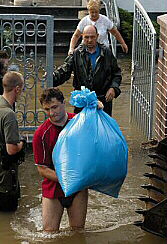 |
| The Danube near Vienna (August 2002). |
Last summer will be remembered as „the summer of the millennium“
for the bad news that it brought to Europe: half of the European landscape
sank into water and mud in the summer of 2002. Many people lost the property
they had worked for all their life. To prevent a similar catastrophe from
happening in the future, it is high time efficient flood protection measures
were put in place.
As to the International Commission for the Protection of the Danube River
(ICPDR), it has included flood prevention into its five-year Joint Action
Programme 2001-2005 which stresses the importance of creating a flood prevention
programme adapted to the specific situation in the Danube River Basin with
particular attention to the tributaries and sub-river-basins. The results
should be available by the year 2005.
The 1st expert meeting of the ICPDR on flood protection was held in Budapest
in September 2001, i.e. approximately a year before the superflood occurred.
The participating experts agreed on the need to develop an action programme
for sustainable flood prevention in the Danube River Basin. They agreed
that the programme should follow the UN-ECE Guidelines on Sustainable Flood
Prevention and that it should also take into consideration – as a model
- the Action Plan on Flood Defence of the Rhine Commission.
In response to this proposal and bearing in mind the great diversity of
the hydrological conditions in the Danube River Basin, the Danube countries
are currently developing action programmes for sustainable flood prevention
for the sub-basins and/or for selected parts of the Danube River itself.
The Danube countries are also preparing reports on their flood protection
activities and existing bilateral and/or sub-basin-wide cooperation for
flood prevention and forecasting, which should be available in October 2002.
The reports will immediately be thoroughly analysed and the ICPDR will at
its forthcoming Plenary Session in November 2002 decide on specific actions
to minimize future risks from floods .
One of the problems highlighted by the recent floods concerns the inundation
of landfills, dump sites and storage facilities where harmful substances
are deposited. The possibility of toxic substances being transported into
the water poses a clear threat to the environment as was shown in August
2002 when the Elbe flooded Spolana chemical plant in Neratovice, the Czech
Republic. Such potential threats were recognised by the ICPDR in the past
and already in spring 2002 the Danube countries agreed to create an inventory
of old contaminated sites in potentially flooded areas in the Danube River
Basin.
Preventing floods by restoring nature
 |
| Fleeing the flood in Germany |
In Kärnten, Austria, the Drava River has been freed from its "concrete bodice" and flood areas have been established that are not only new habitats for endangered plants and animals but also a sign of a reversed trend in flood protection policy; the Drava River is a test case for the new "back to nature" approach. The river got back its freedom and is only regulated in those areas where settlements are likely to be overflowed. EU scientists are conducting a long-term study to determine whether the high investment cost associated with the Drava River Project is justified. If it proves to be justified, the „back to nature" approach will be applied to bigger rivers such as the Rhine or the Elbe.
Countries most affected by the flood
Lower and Upper Austria as well as Salzburg took the brunt of the inundation.
More than 10.000 houses were damaged. The infrastructure in these regions
was destroyed, with the cost of infrastructure rehabilitation estimated
at EUR 232 million. The total damage has been roughly estimated at between
EUR 5 – 7.5 billion, with private and state-owned property accounting
for about 60% and 40% of that amount respectively.
In the Morava River Basin in the Czech Republic, about 20 communities were
affected by inundation. The major damage inflicted on urban settlements,
infrastructure and agriculture has been estimated at EUR 11.7 million, with
municipal and private property representing EUR 7 million and EUR 4.7 million
respectively.
In Slovakia, the areas most affected by inundation involved central Slovakia
and the area around Bratislava. 144 settlements and 8,678 hectares of the
land were flooded. The damage is estimated at EUR 36.2 million and the cost
of the emergency interventions amounted to EUR 2.2 million.
 |
| Impression from Upper Austria in August 2002. |
In the inundation area around the Danube elbow near Visegrad, in Hungary,
several municipalities were affected. About 2,000 people had to be evacuated.
4,370 houses were damaged. However, due to flood prevention structures and
emergency interventions, major damages could be prevented. The overall cost
of the emergency operation was EUR 33 million and the estimated cost of
rehabilitation of flood defence structures is EUR 10.2 million.
Flash floods in the Suceava region in northern Romania caused 11 casualties;
1,624 houses were flooded and more than 1,000 kilometers of roads and 567
bridges were destroyed. Serious damage was inflicted on gas, electric and
communication networks. The damage has not yet been estimated.
The inundation in Bavaria affected the Danube from Regensburg to Passau
and many tributaries including the Inn, the Traun, the Salzach and the Regen.
Thanks to the flow regulation structures in place, the negative impact of
flood was substantially reduced. The utilization of reservoirs at Dillingen
and Ingolstadt helped to decrease the flood wave remarkably. The overall
estimation of damage on flood protection structures is EUR 0.5 million,
of which EUR 7.3 million will be covered from the state budget the rest
will be provided by the municipalities. The extent of the damage on infrastructure
and private property is still being estimated.